Harris Nature Center's Resident Birds
American Crow: Onyx

Onyx was found as an orphaned fledgling in 2018. Due to this species’ extreme intelligence, he was quickly imprinted on his rescuers before he was taken to a wildlife rehabilitation center. Being imprinted means that Onyx relies on humans in order to survive and this impairs his ability to survive in the wild. Onyx came to HNC in 2019 and will live out the rest of his life here.
Eastern Screech Owl: Eclipse
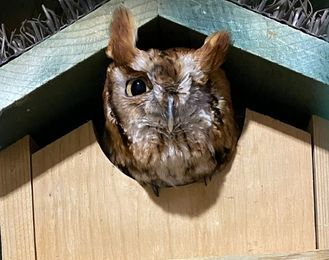
Eclipse came to HNC after being hit by a car in 2020 and receiving treatment at the Wildside Rehabilitation Center in Eaton Rapids. Her left eye is missing and she can not be returned to the wild. Eclipse will remain a permanent resident at the Harris Nature Center to help us teach people of all ages about birds, raptors, camouflage and nocturnal wildlife.
Red-tailed Hawks: Aztec and Talon

The Red-tailed Hawks at the Harris Nature Center both have permanent wing injuries and came to live here in April of 2012. Talon was found at a construction site in Okemos in 2010 with his broken wing already improperly healed. It is assumed that his mate fed him during the mending process, or else he would not have survived. Aztec, still a juvenile at the time and obviously injured, was spotted in the road near Webberville in 2008. As a young bird not yet adept at hunting, Aztec may have been feeding on road-kill and been hit by a car. Both hawks will remain permanent residents for the remainder of their lives.
Harris Nature Center's Resident Reptiles
Eastern Box Turtle: Tyco
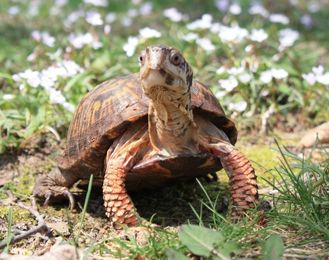
Tyco was likely born in 1995 and purchased in a pet store as a hatchling. He was donated to the Harris Nature Center in April of 1998. Tyco was the first turtle to live at the nature center and remains the first turtle exhibit you see as you enter the Harris Nature Center. Tyco’s friendly personality made it an easy decision to select the Eastern Box Turtle as the Harris Nature Center logo.
Eastern Box Turtle: Cargo
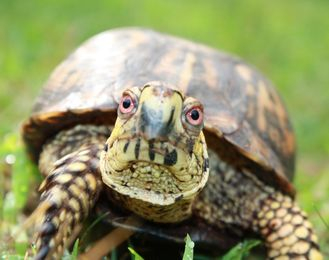
Cargo was originally part of an Eastern Box Turtle study area where Herpetologists from Michigan State University were tracking their movements. During a field survey, researchers spotted a raccoon trying to eat this box turtle, so they scared the raccoon away and rescued the box turtle. Cargo lost a front leg in the incident and can no longer thrive in the wild, so he will spend the rest of his years at the nature center where he helps visitors learn about his species.
Eastern Box Turtle: Shirley
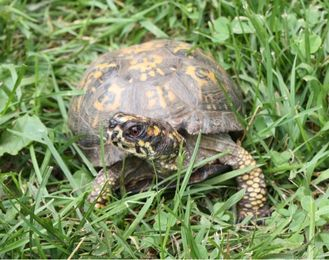
Shirley was brought to the Harris Nature Center in the summer of 2009. She had been kept in captivity for over 10 years prior to coming to the nature center, so she is no longer able to survive on her own in the wild. Shirley is housed with another female Eastern Box Turtle named Sienna. They enjoy burying themselves close to each other as well as climbing on each other’s backs!
Eastern Box Turtle: Tiger

Tiger shares his story with another Harris Nature Center (HNC) turtle named Shirley. These two Eastern Box Turtles came to HNC from Traverse City, Michigan where they were kept in captivity for over 10 years. When it was determined that they could no longer survive on their own in the wild, they were brought to HNC on July 19, 2009. Tiger’s nickname is “Superman” because he leaves all four legs out, as if flying, each time he visits with children.
Eastern Box Turtle: Sienna
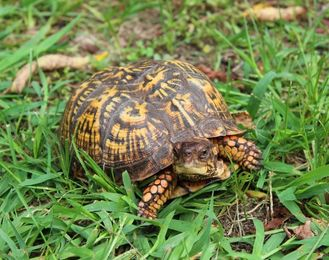
Sienna came to the Harris Nature Center (HNC) on May 2, 2017. She was injured in the wild and as a result, lost one of her back legs. Sienna is housed with another female Eastern Box Turtle named Shirley. Sienna likes to spend a lot of time buried in the dirt or hiding under her food bowl. Sometimes, she even likes to hide under Shirley!
Wood Turtle: Carver
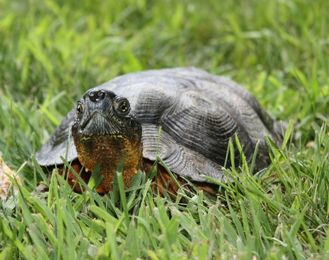
Carver first arrived at the Harris Nature Center on September 23rd, 2010 with many injuries he had acquired in the wild. Carver lost both of his front feet and a large portion of his tail, but after multiple surgeries and extensive rehabilitation from reptile veterinarians, he regained his health, healed well and came back home to the nature center on July 8th, 2011. Carver has adapted well to living with only 2 legs and his enclosure at the Harris Nature Center was built with special considerations to accommodate him.
Common Snapping Turtle: Brewer
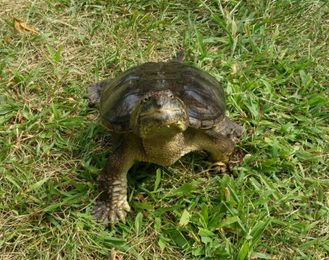
Brewer was rescued from a poacher in Wisconsin who kept him illegally as a “pet” for 5 years. The Milwaukee Humane Society contacted HNC in 2011 in hopes of finding a home for this Snapping Turtle. HNC gladly accepted and on April 5, 2011, Brewer flew on an airplane to Michigan to live out his life at the Harris Nature Center. Brewer was named after the Major League Baseball team in his home town and is now an HNC favorite to hundreds of visitors each year.
Common Snapping Turtle: Keeva
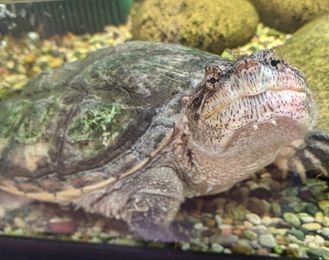
This Common Snapper Turtle, once kept illegally as a pet and then abandoned, was found by her rescuers in an empty apartment in Hillsdale, Michigan. She came to the Harris Nature Center on November 22, 2020 with several health issues, but is now thriving in her new habitat. The name Keeva, meaning gentle, was given to this turtle for her uncommon Snapping Turtle demeanor.
Painted Turtle: Picasso
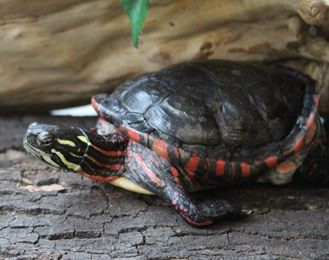
Picasso was brought to the nature center in June of 2007 after being kept as a pet during her first years of life. Before coming to HNC, she did not receive the proper nutrients during that crucial time in her life which left her with a visual growth defect. When you visit, you’ll notice that her shell turns upward around the edges. This has impacted her ability to remain safe in the wild, but has not stopped her from enjoying life at HNC. Picasso enjoys swimming all over her exhibit and is quick to greet her visitors.
